Ski: 2023-2024 Blizzard Sheeva 10, 180 cm
Test Location: Crested Butte Mountain Resort, Colorado
Days Skied: 6
Available Lengths: 156, 162, 168, 174, 180 cm
Blister’s Measured Tip-to-Tail Length (straight-tape pull): 178 cm
Stated Weight per Ski (164 cm): 1735 grams
Blister’s Measured Weight per Ski: 1851 & 1856 grams
Stated Dimensions: 133.5-102-122.5 mm (164 cm)
Blister’s Measured Dimensions: 134-102-123 mm
Stated Sidecut Radius (180 cm): 17.5 meters
Measured Tip & Tail Splay (ski decambered): 75 mm / 39 mm
Measured Traditional Camber Underfoot: 4 mm
Core Materials: poplar, paulownia, and beech core + titanal + fiberglass laminate
Base: sintered
Factory Recommended Mount Point: -7 cm from center; 81.5 cm from tail
Boots / Bindings: Tecnica Cochise Pro W, Fischer RC4 MV BOA, Fischer RC4 MV Buckle; Tyrolia Attack 14

Intro
The Blizzard Sheeva series has been a staple in Blizzard’s ski lineup for quite a while now, and in that time, we have seen (and skied) a few iterations. Blizzard announced their new 23/24 Rustler and Sheeva series earlier this year, with updates including the addition of their fine-tuned Trueblend Woodcore, a different implementation of the piece(s) of metal that overlay the wood, and a slight difference in the sidecut and rocker profiles of the skis.
We have spent a lot of time on the Sheeva 9, 10, and 11 in the past, and I used the last iteration (19/20–22/23) as a personal ski for a couple of seasons.
Between lots of days on different versions and a couple of different lengths, it has been exciting to see what the redesigned Sheeva 10 is all about and how this new version is both similar and different from its predecessor.
Women-Specific Aspects of the Sheeva Series
Blizzard takes a more concerted “women-specific” approach to ski design than many brands, in the form of their Women2Women project. Here’s a bit more info from Leslie Baker-Brown, Blizzard-Tecnica’s Women2Women Project Lead:
“We worked with our female ambassador and athlete groups throughout the development process to ensure that we were making a collection of freeride skis that would work for all levels of women. Because the skis are specifically engineered at each length and we’ve shortened the length increments, we really are able to reach a broader range of skiers.”
In addition to a design and prototyping process that works closely with their Women2Women team, the new Sheeva skis are slightly different in their construction, relative to the Rustlers, mostly in that the Sheevas have a piece of fiberglass that overlays the binding area of the ski, rather than the additional piece of titanal metal that the Rustlers have in that spot.
What Blizzard says about the Sheeva Series
“She Wolves lead the pack, moving quietly between the lines. They’re fierce, confident, independent, and quite simply – badass. But She Wolves are stronger in a pack, and you know a wolf pack when you see one. They’re the ones having the most fun, tearing up the mountain with a “go ahead and watch me do it” attitude, leaving behind only fresh tracks, breathless belly laughs, and inspiration for other women to join. We’ve completely redesigned the Sheeva with these ladies in mind, engineered specifically to the wants and needs of the She Wolves: Confidence, control, power, and above all, fun. So get out there, find your pack, and Press Send.”
Construction
The new Sheeva and Rustler series feature Blizzard’s “Trueblend Freeride Woodcore,” which consists of a variety of precisely placed stringers of poplar, paulownia, and beech woods. The goal is to put denser, stiffer materials (i.e., the beech) where you need them, while placing lighter, softer materials (paulownia and poplar) where stiffness is less of a priority and you’re instead looking to minimize swing weight. While many skis’ wood cores contain a variety of stringers of different types of wood, Blizzard’s Trueblend construction seems to be notably more complex and allows for finer-tuning of core characteristics.
The Sheeva series is built with Blizzard’s “FluxForm W.S.D” (Women-Specific Design). FluxForm utilizes two separate pieces of titanal over the edges of the skies from tip to tail, and these titanal pieces taper as they get closer to the tip and tail (this is true of both the Rustler and Sheeva). But, in the Sheeva series, there is a piece of fiberglass that overlays the binding area, rather than an additional piece of titanal as with the Rustler series. The narrowest Sheeva 9 features the most metal over its edges, while the widest Sheeva 11 features the least, and the middle-child Sheeva 10 falls somewhere in between.
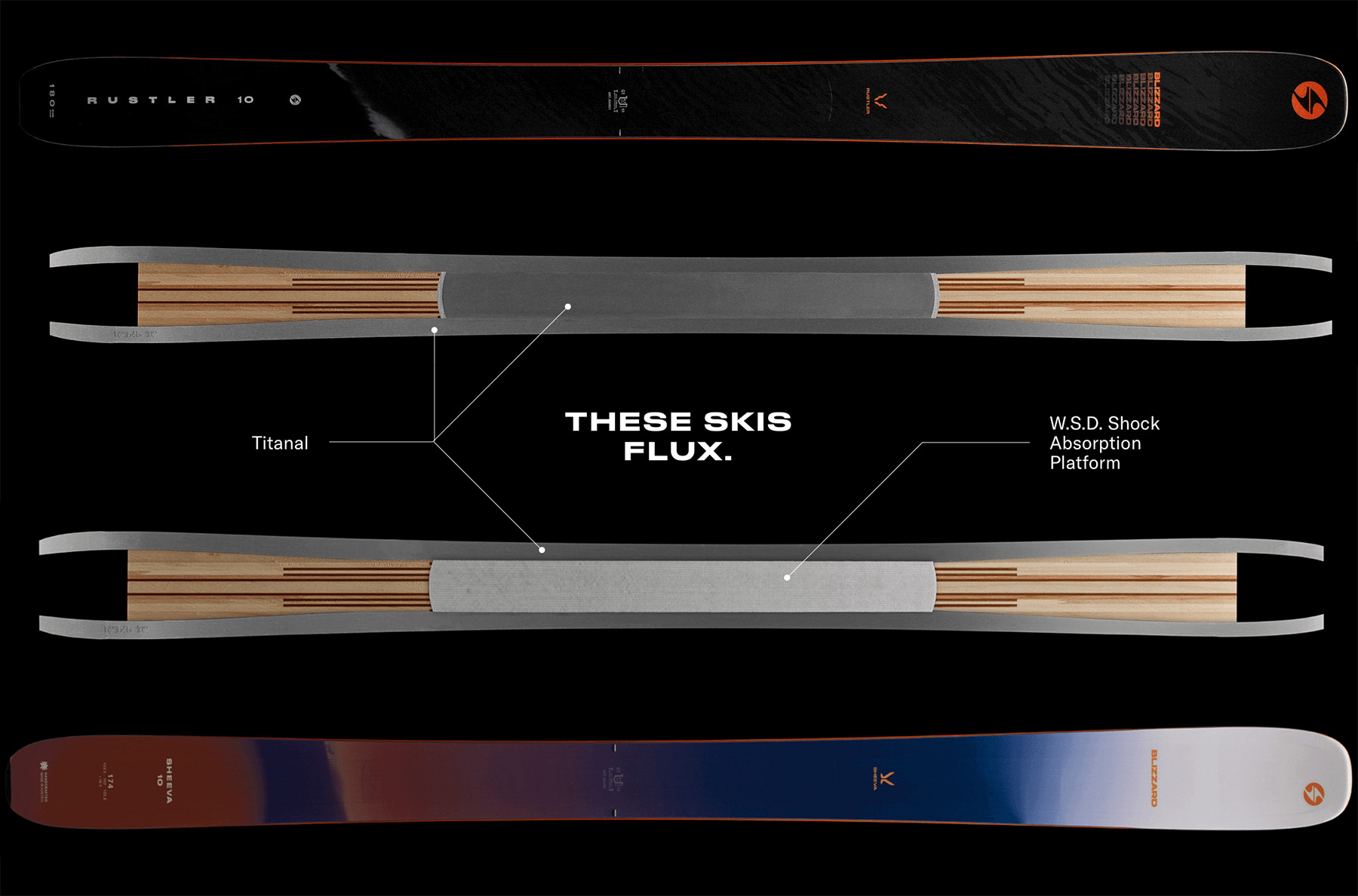
Shape / Rocker Profile
While somewhat similar to its predecessor, the Sheeva 10 features a couple of minor modifications when it comes to its shape and rocker profile. On the shape side, this is mostly in the form of a slightly more squared-off tip shape.
Blizzard also made the Sheeva 9 and 10’s rocker lines a bit shallower than the previous versions, in an effort to improve firm-snow performance. The changes appear fairly subtle; this ski still has pretty deep tip and tail rocker lines and a notable amount of tip and tail splay (much more so than Blizzard’s Black Pearl series). Here are the new and old Sheeva 10 numbers side-by-side for direct comparison:
Sheeva 10, 180 cm (19/20–22/23)
Measured Dimensions: 132-100-122.5 mm (180 cm)
Stated Radius: 17.5 m (180 cm)
Measured Weight per Ski: 2011 & 2022 grams
Measured Tip-to-Tail Profile: 72 mm / 4 mm / 38.5 mm
Sheeva 10, 180 cm (23/24)
Measured Dimensions: 134-102-123 mm (180 cm)
Stated Radius: 17.5 m (180 cm)
Measured Weight per Ski: 1851 & 1856 grams
Measured Tip-to-Tail Profile: 75 mm / 4 mm / 39 mm
So, as you can see, no drastic changes here. The most notable difference is the weight discrepancies between these two versions (more on that below).
Flex Pattern
Here’s how we’d characterize the flex pattern of the Sheeva 10:
Tips: 7
Shovels: 7-7.5
In Front of Toe Piece: 8-9.5
Underfoot: 9.5
Behind Heel Piece: 9.5-8
Tails: 7.5-7
Overall, the flex pattern of the new 23/24 Sheeva 10 feels pretty similar to the previous 19/20–22/23 version, with the main difference being that the new ski is slightly stiffer overall. Still, it has a fairly symmetrical flex pattern that’s notably softer overall than the Blizzard Black Pearl 97.
Dimensions & Sidecut Radius
Not much to report here. There are slight differences with some of the dimensions, a millimeter here or there, but the new Sheeva 10 shares the same stated sidecut radii.
Mount Point
The Sheeva 10 has a recommended mount point of -7 cm from true center, which is a bit closer to center than some more traditional, less rockered skis, but not as close to center as most freestyle-focused models.
Weight
The 23/24 Sheeva 10 is a bit lighter than the 19/20–22/23 version, with the difference on our pairs of the 180 cm lengths being about ~160 g per ski. While this isn’t a massive difference, it is definitely worth noting. Compared to the whole market, the 23/24 Sheeva 10 sits around the middle of its class of ~100mm-wide all-mountain women’s skis when it comes to weight.
For reference, here are a number of our measured weights (per ski in grams) for some notable skis. Keep in mind the length differences to try to keep things apples-to-apples.
1676 & 1700 Majesty Vadera Carbon, 176 cm (22/23–23/24)
1693 & 1710 Moment Sierra, 172 cm (21/22–23/24)
1709 & 1710 Blizzard Sheeva 10, 172 cm (17/18–22/23)
1735 & 1740 K2 Mindbender 106C, 175 cm (21/22–22/23)
1741 & 1747 Nordica Unleashed 98 W, 174 cm (22/23–23/24)
1752 & 1751 Blizzard Sheeva 9, 172 cm (23/24)
1761 & 1778 Zag Slap 104, 176 cm (21/22–23/24)
1787 & 1798 Faction Dancer 2X, 172 cm (22/23–23/24)
1792 & 1792 Nordica Santa Ana 104 Free, 172 cm (20/21–23/24)
1797 & 1839 Rossignol Rallybird 102, 170 cm (20/21–23/24)
1806 & 1821 Blizzard Sheeva 11, 172 cm (18/19)
1797 & 1839 Rossignol Rallybird 104 Ti, 171 cm (20/21–23/24)
1836 & 1838 Armada ARW 106 UL, 180 cm (21/22–23/24)
1847 & 1854 Wagner Summit 106, 172 cm (21/22–23/24)
1851 & 1856 Blizzard Sheeva 10, 180 cm (23/24)
1860 & 1862 Majesty Vadera Ti, 176 cm, (22/23–23/24)
1867 & 1890 K2 Mindbender 115C, 179 cm (21/22-22/23)
1878 & 1891 Salomon QST Stella 106, 173 cm (22/23–23/24)
1881 & 1895 Salomon QST Lumen 99, 174 cm (19/20–21/22)
1917 & 1935 Nordica Santa Ana 98, 172 cm (20/21–23/24)
1928 & 1945 K2 Mindbender 99Ti W, 172 cm (22/23–23/24)
1933 & 1975 Volkl Secret 96, 170 cm (21/22–23/24)
1955 & 1990 Coalition Snow SOS, 173 cm (19/20–20/21)
1958 & 1960 Faction Dancer 3X, 172 cm (22/23–23/24)
1969 & 1988 4FRNT MSP CC, 171 cm (20/21–22/23)
1959 & 1986 Blizzard Sheeva 11, 180 cm (23/24)
2011 & 2022 Blizzard Sheeva 10, 180 cm (19/20–22/23)
2068 & 2178 Salomon QST 106, 181 cm (22/23–23/24)
2074 & 2088 Line Blade Optic 104, 178 cm (22/23–23/24)
2104 & 2115 Volkl Secret 102, 170 cm (19/20–22/23)
Now, onto how all of this translates on snow:
FULL REVIEW
Groomers
Kara Williard (5’9”, 167 lbs / 175 cm, 75.7 kg): The Sheeva 10 has historically stood out to me as a ski that carved well for its width, and this holds true for the latest version. The Sheeva 10 has a flex pattern and shape that allow you to easily lay it on edge with relatively low effort, and once there, it maintains a pretty smooth and stable feel, which is most impressive when groomers are on the grippier side (i.e., not super icy or scraped-off). While it’s not the most precise carver, given its deep rocker lines, it still allows for stable carving at high speeds.
The Sheeva 10 will allow you to finish turns with precision on edge and transition into the next with some pop, it’s also totally fine for slarving and slashing, and this turn-type versatility allows for good carving practice on groomers.
When A/B testing the 23/24 172 cm Sheeva 9 vs. the 23/24 180 cm Sheeva 10, it became apparent that the Sheeva 9 feels notably more precise, stable on edge, and locked in, particularly when the groomers are firm / scraped off. Overall (and not surprisingly), I prefer the Sheeva 9 on firm conditions and the Sheeva 10 on softer conditions; if deciding between the two, it should be a fairly straightforward decision, based on where you ski and the conditions you’re looking to prioritize.
There are plenty of all-mountain skis that are a whole lot more powerful and precise on groomers, but most of those skis don’t offer some of the soft-snow versatility that I speak to next. But for those who want a very stable ski that’s capable of laying down hard, fast carves on very firm snow, something less rockered and heavier will be a bit better, such as the Blizzard Black Pearl 97 or Volkl Secret 96.
Soft Chop & Powder
The Sheeva 10 felt most predictable and at home in softer snow conditions, whether that be fresh and untracked or skied-out chop. This is where I found myself really enjoying the mixture of maneuverability and stability that the Sheeva 10 provides, and this is definitely where the Sheeva 10 felt most intuitive.
The Sheeva 10 does a pretty good job of allowing you to make larger turns down the fall line while still being capable of cutting quicker, tighter turns across the slope. This is ideal when you encounter varying densities of snow and need to switch up your turn shapes on the go, and is also useful when skiing variable terrain, from steep and open to lower-angle and tight.
The Sheeva 11 is a notably better ski for the deep days, with better flotation and composure at speed, but the Sheeva 10 is still pretty fun in all sorts of soft conditions, and it’s a whole lot more maneuverable (and in my opinion, just more fun) in these conditions than the stiffer, less rockered Black Pearl skis.
Firm Chop / Crud
The Sheeva 10 handles firmer, more roughed-up conditions fairly well, sitting somewhere in the middle of the spectrum; it’s neither super damp and planted nor ultra-loose and forgiving.
The Sheeva 10 offers fairly good suspension for its class, which helps it stay fairly composed in crud at moderate speeds, but it certainly isn’t the most planted. If you are looking for the most smooth and plush ride for charging through chop, or a more playful, easygoing ride, you will probably want to deviate in one direction or another. But for those who don’t want to go with either end of the spectrum, the Sheeva 10 warrants a look.
I also found the wider, slightly heavier Sheeva 11 to feel a bit more composed in pretty roughed-up snow, and overall, it seems like the better option for those who want a more stable ski in chop and crud.
I mentioned in my Flash Review of the Sheeva 10 that I was experiencing some tip deflection with the newest version of this ski. After several more days, and some significant detuning of tips and tails, I still find the ends of the ski to be prone to being knocked around a bit in really variable conditions. That said, when comparing it to the 19/20–22/23 version (a personal ski that I have kept around for a few seasons and that I have detuned significantly), the 23/24 version feels more predictable and less prone to hooking up in variable conditions, which is a significant improvement. Detuning the shovels didn’t necessarily increase how planted the Sheeva 10 felt, but it did help to make the ski’s edge hold feel more consistent and predictable in variable conditions.
Still, you can still feel some feedback and deflection occurring in the shovel of the new Sheeva 10, and the firmer or more inconsistent the snow, the more obvious this felt. Folks looking to the Sheeva 10 for its maneuverability and liveliness may not find this to be an issue, but I do think it’s worth mentioning for those who prioritize a particularly composed, planted ride in rough snow.
Moguls, Trees, & Tight Terrain
Moguls and tight terrain are where the quickness, maneuverability, and liveliness of the Sheeva 10 really shine. The Sheeva 10 is easy to whip around, feels quite energetic, and it’s quick to both initiate and release turns. In many ways, I consider the Sheeva 10 to be an ideal bump ski. I have felt this way about previous versions, but the latest iteration’s flex pattern feels the most consistent from tip to tail, and I also find it to feel a tad looser and easier to pivot in tight terrain.
In tight terrain, I generally find the Sheeva 10 to be a comforting ski. While it initiates and releases pretty easily, it also provides some good stability underfoot, translating to a supportive yet accessible experience when skiing tight terrain in firmer or chalkier conditions.
Length
Over the years, I have spent a lot of time on both the 172 cm Sheeva 10 (and Sheeva 11) and 180 cm Sheeva 10 (and Sheeva 11). It’s worth noting that I consider myself a slightly stronger skier now than when I first reviewed the original 172 cm length, and the 19/20–22/23 version in a 180 cm. As of now, the 180 cm Sheeva 10 feels like the right length for me. For reference, I tend to prefer lengths anywhere from 170-185 cm, depending on the ski.
While Crested Butte has some pretty tight terrain, I found the 180 cm to feel pretty manageable when having to make precise turns in those zones. The tail is forgiving enough that I didn’t have to worry about it bucking me in consequential terrain, and the Sheeva 10 pivots pretty easily even without having to drive the shovels with a whole lot of power.
The Sheeva 10 can be skied with power or finesse (or a mix of both). While I don’t think everyone should size up or down, I think it might make sense to go for the longer length if you are caught between sizes, given the deep rocker lines of the Sheeva 10. I have a feeling that the 172 cm Sheeva 10 would feel pretty short to me these days, and while it might be a worthwhile option if I really wanted to prioritize maneuverability and accessibility, the longer length offers more stability while still feeling quite maneuverable overall.
Mount Point
As I just mentioned, the Sheeva 10 is a pretty adaptable ski that can work for skiers with different styles. The Sheeva 10 has a slightly more centered recommended mount point (-7 cm from true center) than some more directional all-mountain skis out there, but I would still classify it as a ski that can work pretty well for directional skiers who are looking for a maneuverable ski.
As someone who tends to ski quite directionally with a forward stance, the Sheeva 9, 10, and 11 all feel quite intuitive to me when mounted on their recommended mount points, though the Sheeva 9 definitely feels the most directional and offers the most obvious support and contact through its tail. I never felt inclined to move away from the Sheeva 10’s recommended line, though I will likely try the wider Sheeva 11 mounted slightly farther back and report on that in the full review of that ski, later this season.
Who’s It For?
For quite some time, I have considered the Sheeva 10 to be a prominent option when it comes to a 1-ski quiver that will favor softer snow conditions, but that’s still quite capable on firmer snow. In fact, I selected the previous Sheeva 10 for just that in our Reviewer Ski Quiver Selections (see my 1-ski quiver selection from 20/21).
This holds true with the latest 23/24 Sheeva 10, and I find the latest tweaks help the Sheeva 10 feel even a bit more accessible in the form of a slightly lower swing weight; a little easier to pivot in tight spots, and a bit more predictable in rough snow conditions.
That said, the Sheeva 10 does feel like a ski that sits around the middle of the performance spectrum in many regards. So for someone who wants a really damp and stable charger, or someone who prioritizes maximum playfulness and maneuverability, there are certainly skis that will cater to your preferences, one direction or the other.
But if you are looking for a ski that does a lot of things quite well, is a bit biased toward soft snow conditions, and excels when making quick turns in moguls, trees, and tight terrain, I think the Sheeva 10 is a solid option.
Bottom Line
The Blizzard Sheeva 10 is situated in the middle of the recently revised Sheeva series, making it a versatile option when it comes to different terrain and conditions. The narrower Sheeva 9 might be a better choice for someone who wants a ski that will excel on firmer snow, while the Sheeva 11 makes more sense for those looking for a pretty versatile powder ski. But the Sheeva 10 does a lot of things well, feeling agile and maneuverable in tight off-piste terrain and still carving quite well on most groomed surfaces. It’s neither ultra-stable nor extremely playful, but that middle-of-the-road approach results in a ski that has the potential to work for a wide range of skiers.
As I mentioned in the Flash Review, those who loved the previous Sheeva 10 shouldn’t stress about the updates made to the latest iteration; I can safely say that the changes, while somewhat subtle, have felt like worthwhile improvements.
Deep Dive Comparisons
Become a Blister Member to check out our Deep Dive comparisons of the latest Sheeva 10 to see how it compares to the previous Sheeva 10, new Blizzard Sheeva 9, new Blizzard Sheeva 11, Nordica Unleashed 98 W, Salomon QST Stella 106, Armada ARW 106 UL, Blizzard Black Pearl 97, Faction Dancer 3X, Fischer Ranger 102, K2 Mindbender 106C, Line Blade Optic 104, Nordica Santa Ana 104 Free, ZAG Slap 104, Head Kore 103 W, & Volkl Secret 102.

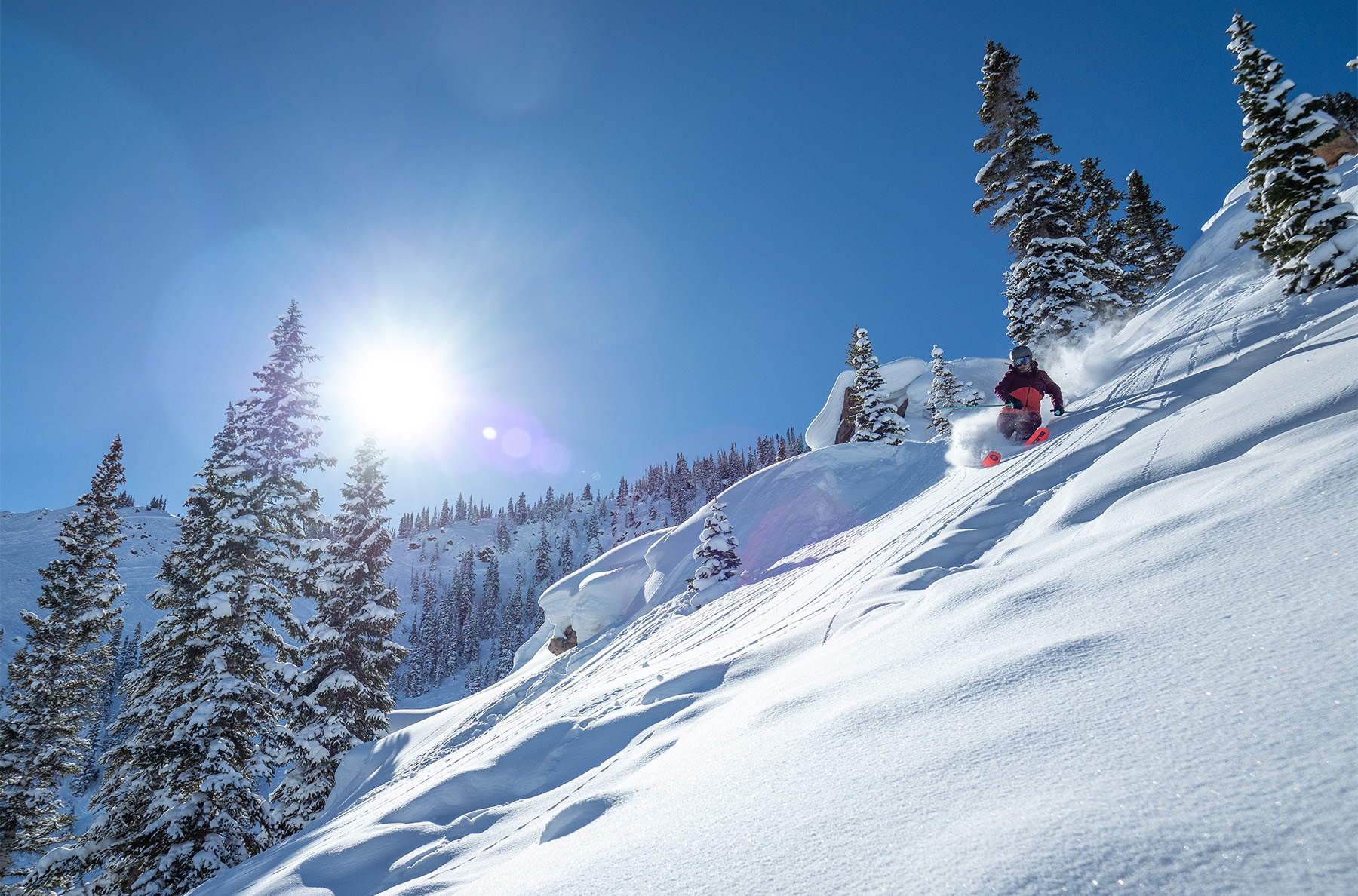


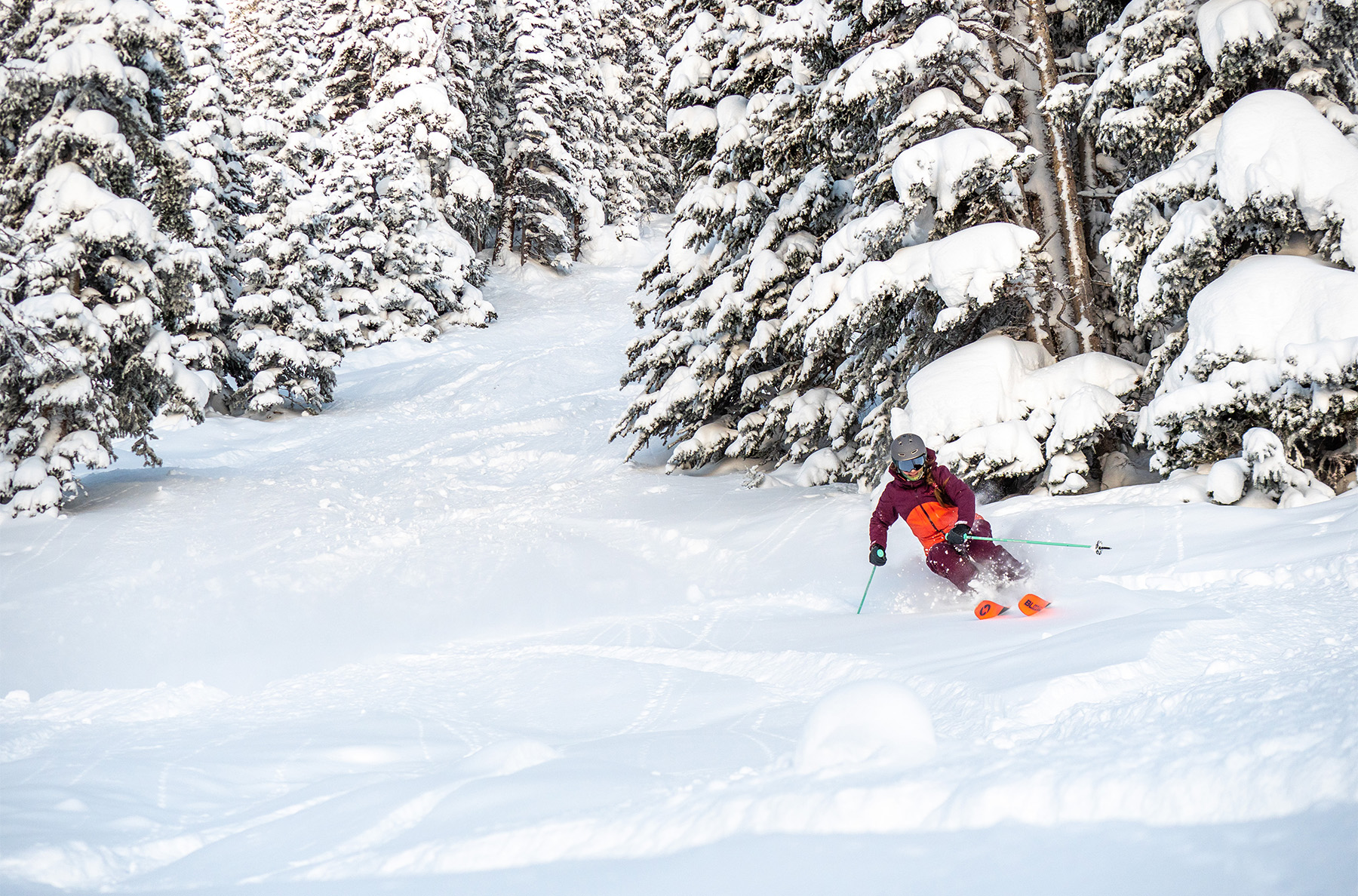
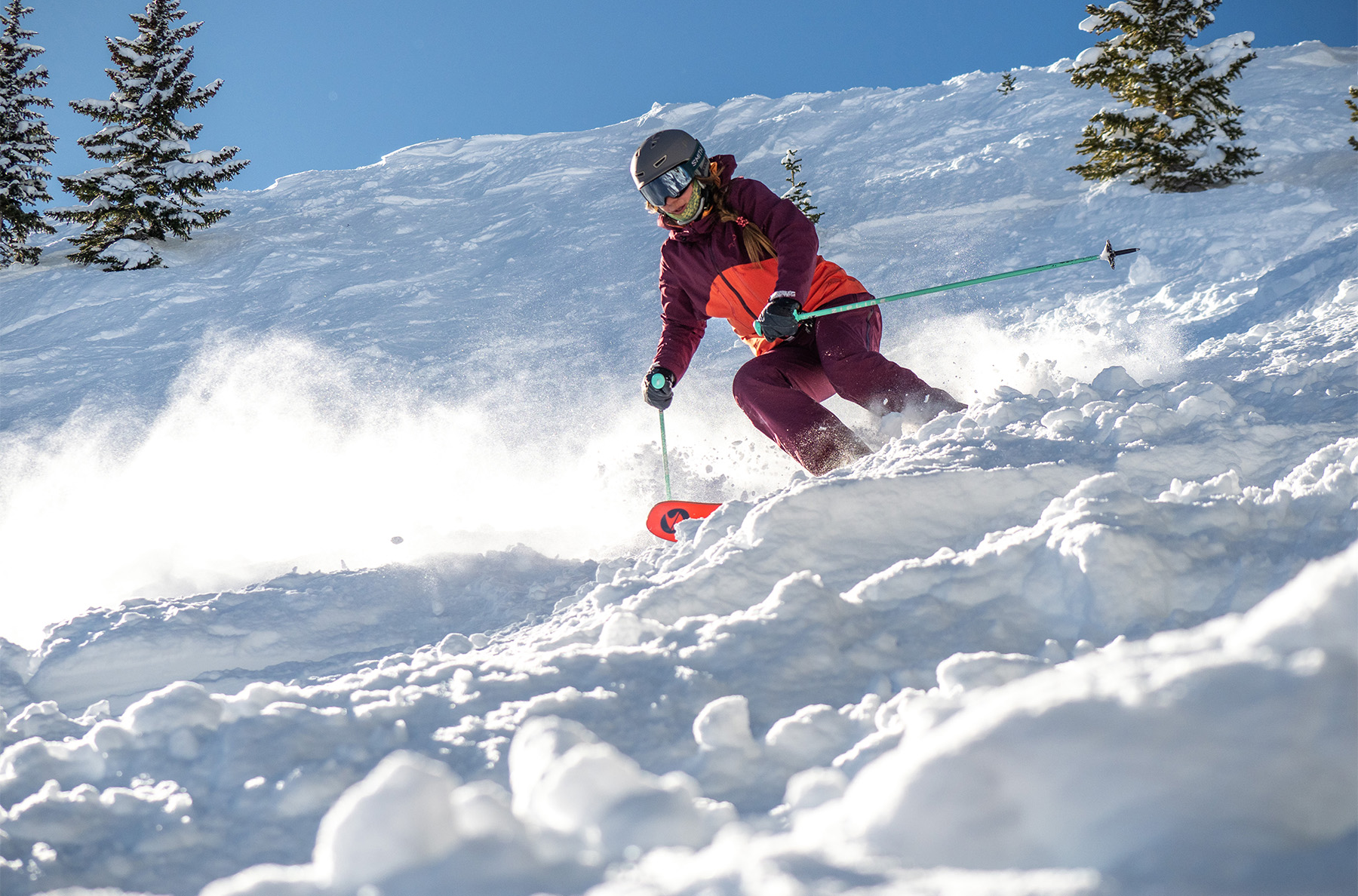
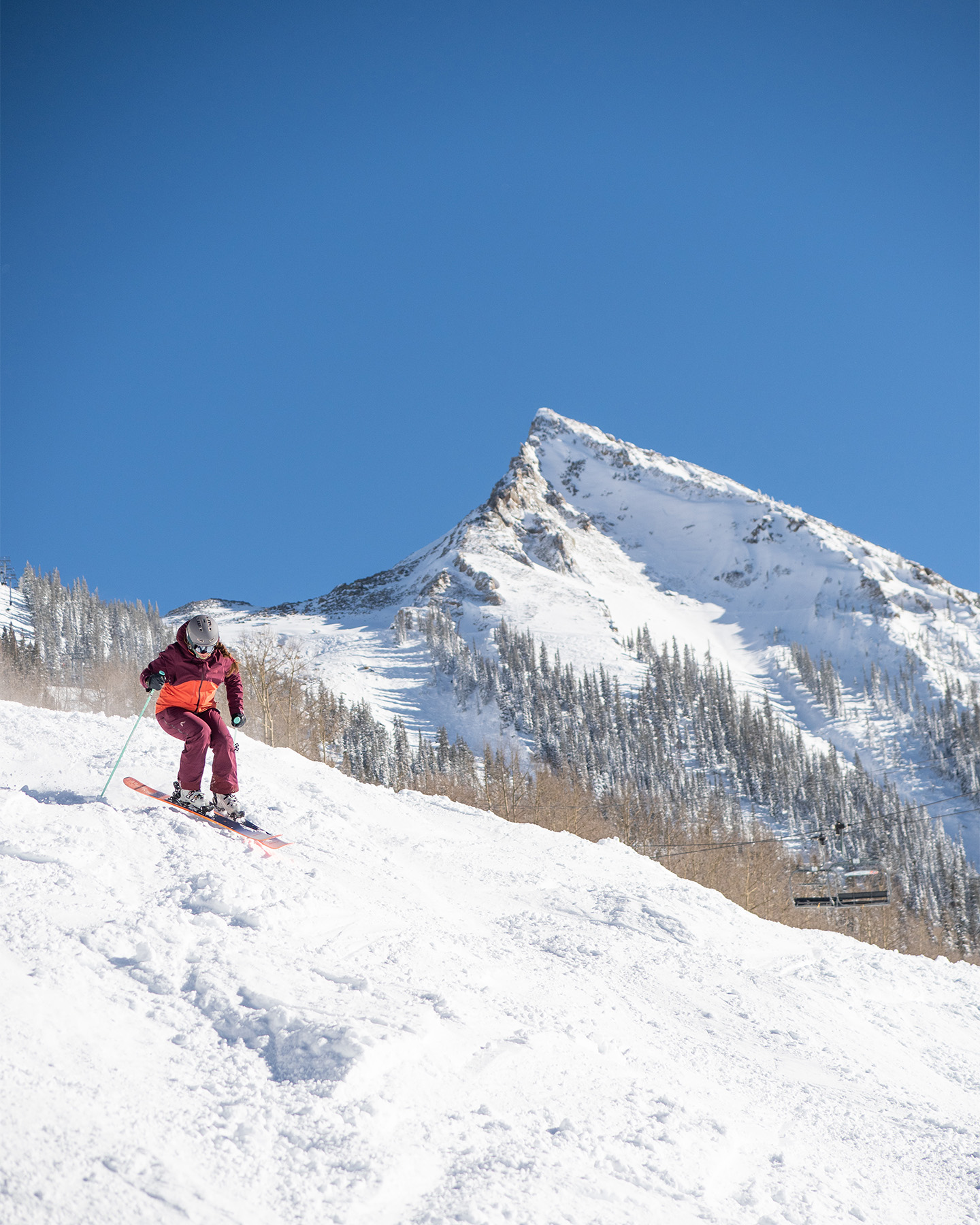
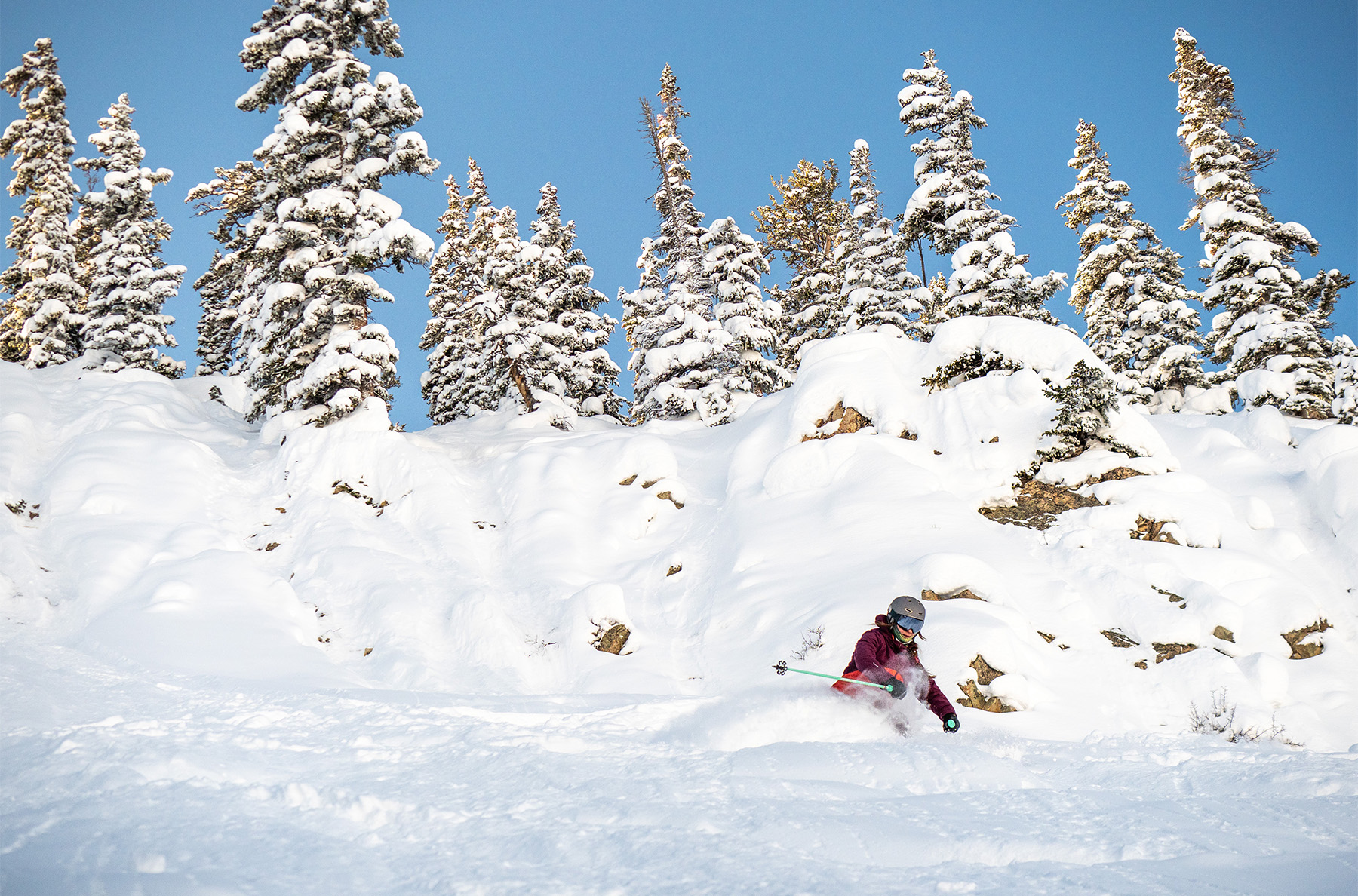
cool ski – probably one of the better looking rustler/ sheevas out there, but feels like you might be holding back a little Re: Fischer RC4 MV BOA, Fischer RC4 MV Buckle – let’s hear it!
Have been hearing from lots of folks who have demoed these and the new Rustlers that the new ones aren’t nearly as playful and fun. Haven’t had anyone say they like them better. What’s your opinion? Thanks
This is a great ski. I demoed last year’s ski, very similar to the Black Crow Justis, lighter, less power, more flex, quicker turning radius, not as good at carving. Ski is very playful. I think the ski performed great with the Squire Demo binding, which allows the skier to change the mount point on slope. I have only skied them at Palisades. I felt the ski lacked power to handle certain positions like Chute 75 or the Main Chute or Corkscrew off of Granite Chief, but those are steep and technical positions. I thought mogul skiing was great fun, and tree skiing was optimal. The front of the ski is more parabolic than my preference, and at high speeds, carving on variable transitions, like Red Dog base, the ski became unstable and pre-released, which I was testing. I don’t think that would happen with a Volkl Secret, which I purchased for my daughter. Having said that, lighter is the way to go. I think this ski on a Squire Demo binding with a Lange XT3 Free 115 Boot is extremely comfortable, and will handle almost every tree position, and also most off piste positions, the exception being the over skied drop ins to the slope.